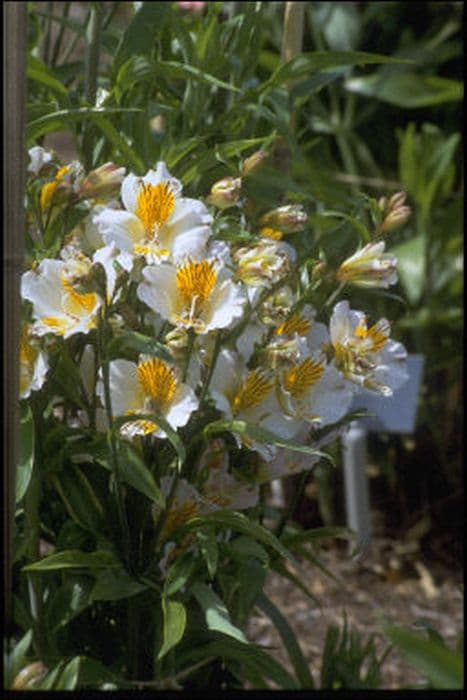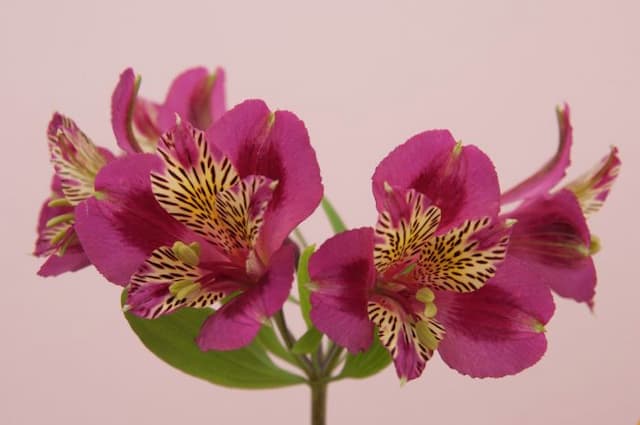Peruvian Lily Alstroemeria 'Red Elf'

ABOUT
Alstroemeria 'Red Elf', commonly known as the Peruvian Lily or Lily of the Incas, is a striking and vibrant plant. It features eye-catching blooms that exhibit a rich red hue with contrasting flecks and streaks of dark colors, typically dark yellow, which give the flowers a dramatic appearance. The petals are characteristically lily-like with a slight twist or curl, presenting a delicate and intricate look. The flowers of the 'Red Elf' are clustered together at the tip of sturdy, upright stems, and they create an alluring display that can attract the attention of both passersby and pollinators, such as bees and hummingbirds. Surrounding the blossoms is an array of lance-shaped leaves that are glossy and have a lush green color that complements the vividness of the red flowers. Alstroemeria 'Red Elf' blooms are notable for their longevity, both in the garden and when cut for arrangements, making them a popular choice for bouquets and floral displays. The plant overall has a compact, bushy habit, which adds to its visual appeal, creating dense clusters of color that enliven the landscape or indoor settings.
About this plant
 Names
NamesFamily
Alstroemeriaceae
Synonyms
Peruvian Lily, Lily of the Incas, Parrot Lily
Common names
Alstroemeria 'Red Elf'.
 Toxicity
ToxicityTo humans
The Alstroemeria, commonly known as Peruvian Lily or Lily of the Incas, can cause irritation and discomfort if ingested by humans. The plant may contain allergenic compounds that can lead to symptoms such as nausea, vomiting, and diarrhea if parts of the plant are eaten. Additionally, handling the Alstroemeria can sometimes result in dermatitis due to the presence of tuliposide A, a skin irritant, so it is advisable to use gloves when working with this plant to avoid any skin reactions.
To pets
The Peruvian Lily is considered to have low toxicity for pets. If a cat or dog ingests parts of the plant, they may experience mild gastrointestinal upset, including symptoms such as vomiting or diarrhea. It's always wise to monitor your pet and consult a veterinarian if you suspect that they've eaten a significant amount of the plant and are showing adverse symptoms. However, the Peruvian Lily is not usually a cause for major concern in pets compared to other more toxic plants.
 Characteristics
CharacteristicsLife cycle
Perennials
Foliage type
Evergreen
Color of leaves
Mixed
Flower color
Mixed
Height
1-2 feet (30-60 cm)
Spread
1-2 feet (30-60 cm)
Plant type
Herb
Hardiness zones
7
Native area
South America
Benefits
 General Benefits
General Benefits- Eye-catching blooms: Alstroemeria 'Red Elf' features vibrant red flowers that add a splash of color to gardens and floral arrangements.
- Long flowering period: This plant has a lengthy blooming season, providing color from late spring to early fall.
- Attracts pollinators: The flowers attract bees, butterflies, and hummingbirds, supporting local ecosystems.
- Drought-tolerant: Once established, Alstroemeria 'Red Elf' is relatively drought-resistant, making it suitable for water-conscious gardens.
- Low maintenance: It requires minimal care beyond occasional watering and deadheading, making it ideal for busy gardeners.
- Perennial growth: As a perennial, it returns year after year, reducing the need for replanting.
- Versatile plant: It's suitable for borders, containers, and as a cut flower, offering flexibility in landscape design.
 Medical Properties
Medical PropertiesThis plant is not used for medical purposes.
 Air-purifying Qualities
Air-purifying QualitiesThis plant is not specifically known for air purifying qualities.
 Other Uses
Other Uses- Photography: Alstroemeria Red Elf's vibrant red and pink hues make it a popular subject for photographers, particularly those interested in macro photography and botanical themes.
- Edible Cake Decor: The petals of Alstroemeria Red Elf are non-toxic and can be used as a natural and stunning garnish on cakes and desserts, although it's important to ensure they haven't been treated with pesticides.
- Eco-friendly Confetti: Dried petals of Alstroemeria Red Elf can serve as an environmentally friendly alternative to traditional confetti at celebrations.
- Art Inspiration: The striking colors and patterns of Alstroemeria Red Elf can inspire artists and be used as a reference for paintings, textile designs, and other visual arts.
- Jewelry Making: Pressed flowers of Alstroemeria Red Elf can be used in making handcrafted jewelry, such as resin pendants or earrings.
- Dyeing Fabric: The pigments in Alstroemeria Red Elf flowers can be used to naturally dye fabrics or handcrafted paper, adding a unique touch to creative projects.
- Stationery Decoration: Pressed Alstroemeria Red Elf flowers can embellish personal stationery, invitations, or greeting cards for a delicate and personalized element.
- Table Centerpieces: Floating Alstroemeria Red Elf blooms in a bowl of water can create simple yet elegant table centerpieces for events or home decor.
- Floral Ice Cubes: Freeze small Alstroemeria Red Elf blossoms in ice cubes for an ornamental addition to beverages at parties or special occasions.
- Bookmarks: Using laminated Alstroemeria Red Elf petals can create unique and natural bookmarks for book lovers.
Interesting Facts
 Feng Shui
Feng ShuiThe Peruvian Lily is not used in Feng Shui practice.
 Zodiac Sign Compitability
Zodiac Sign CompitabilityThe Peruvian Lily is not used in astrology practice.
 Plant Symbolism
Plant Symbolism- Friendship: Alstroemeria, also known as Peruvian Lily, is often associated with deep bonds and long-lasting friendships due to its enduring nature and the interwoven growth pattern of its leaves, which symbolize intertwined fates.
- Wealth and Prosperity: The bountiful blooms and the plant's ability to reproduce and proliferate are seen as indicators of abundance, making it a symbol for wealth and prosperity.
- Devotion and Mutual Support: The intertwining leaves represent mutual support in relationships, suggesting that those who give and receive an Alstroemeria are devoted to each other's well-being.
- Strength and Resilience: The hardiness of the Peruvian Lily, which allows it to withstand a range of conditions, makes it a symbol of strength and resilience in the face of adversity.
- Achievement and Success: As the flower blooms in a variety of vibrant colors with multiple petals, it symbolizes achievement and the successful completion of tasks.
 Water
WaterThe Peruvian Lily should be watered deeply to establish a good root system, then maintain a consistent watering schedule. Providing about 1 inch of water weekly will suffice, which translates to roughly 0.6 gallons per plant, adjusting for rain. Decrease watering during the winter months when the plant is dormant. Ensure the soil is well-draining to avoid soggy conditions, which can lead to root rot. During the growing season, when the weather is hot and dry, you might need to water twice a week to maintain moisture without overwatering.
 Light
LightPeruvian Lily thrives in full sun to partial shade. The ideal location would provide morning sunlight and afternoon shade, especially in hotter climates to prevent scorching. If grown indoors, place it in a bright, sunny window to ensure it gets enough light to bloom. Adequate light is necessary for the Peruvian Lily to produce its vibrant colorful flowers.
 Temperature
TemperaturePeruvian Lilies prefer temperatures between 65 and 80 degrees Fahrenheit. They can survive minimal frosts, but persistent cold below 28 degrees Fahrenheit can damage the plants. Protect them from cold snaps and ensure they are not exposed to extreme heat above 90 degrees Fahrenheit for extended periods.
 Pruning
PruningPeruvian Lilies benefit from regular deadheading and removal of spent flowers to encourage further blooming. Prune back the plant in late winter or early spring before new growth starts. Additionally, cut back the entire plant by about one-third after the flowering season ends to help it restore energy for the next bloom cycle.
 Cleaning
CleaningAs needed
 Soil
SoilThe Peruvian Lily 'Red Elf' thrives in well-draining, fertile soil with added organic matter, such as compost or peat moss. Aim for a slightly acidic to neutral pH, between 6.0 and 7.0, for optimal growth. A mix of two parts loam, one part sand or perlite, and one part organic matter creates an ideal growing medium for the Peruvian Lily 'Red Elf'.
 Repotting
RepottingPeruvian Lilies, including the 'Red Elf' variety, generally need repotting every two to three years to refresh the soil and provide room for expanding tuberous roots. It's best to repot in the spring before the new growth starts.
 Humidity & Misting
Humidity & MistingPeruvian Lily 'Red Elf' prefers moderate humidity levels, around 40-60%. This mimics its natural environment and helps maintain healthy growth. Avoid placing it in overly dry conditions or locations prone to drafts.
 Suitable locations
Suitable locationsIndoor
Provide bright, indirect light and keep soil evenly moist for indoor Peruvian Lilies.
Outdoor
Plant in a sunny to part-shade spot with fertile, well-draining soil outdoors.
Hardiness zone
7-10 USDA
 Life cycle
Life cycleThe Alstroemeria 'Red Elf', commonly known as Peruvian Lily or Lily of the Incas, begins its life cycle as a rhizome, which sprouts stems and leaves when conditions are favourable, typically in spring. The plant then matures and develops its characteristic funnel-shaped, red flowers, often with streaks and speckles, attracting pollinators for reproduction through the summer months. Following pollination, the flowers produce dry, capsule-like fruits containing numerous seeds. Once the seeds disperse, they may germinate and establish new plants, completing the reproductive cycle. In adverse conditions, such as winter, the above-ground parts of the Peruvian Lily die back, while the rhizomes enter a dormant period underground. With the return of warmer temperatures and adequate moisture, the cycle begins anew with the emergence of fresh growth from the rhizomes.
 Propogation
PropogationPropogation time
Late winter-early spring
The Alstroemeria 'Red Elf', commonly known as the Peruvian Lily or Lily of the Incas, is typically propagated by dividing the rhizomes. The best time to do this is in late winter or early spring before the plant begins its active growth cycle. To propagate by division, carefully dig up an established clump of Alstroemeria 'Red Elf' and gently separate the rhizomes, ensuring that each division has at least one or two growth points, or "eyes." These divisions can then be replanted in well-draining soil at the same depth they were previously growing. Water the newly planted divisions well to help establish them. Over time, they'll grow into mature plants that will produce the striking red flowers characteristic of the 'Red Elf' variety.






![Peruvian lily [Inca Coral]](/_next/image?url=https%3A%2F%2Fplants-admin.emdemapps.com%2Fimages%2Fplants%2F%2Fimages%2F604b5b79b85ce.png&w=640&q=75)
![Peruvian lily [Inca Exotica]](/_next/image?url=https%3A%2F%2Fplants-admin.emdemapps.com%2Fimages%2Fplants%2F%2Fimages%2F604b5ec0e34a9.png&w=640&q=75)
![Peruvian lily [Inca Milk]](/_next/image?url=https%3A%2F%2Fplants-admin.emdemapps.com%2Fimages%2Fplants%2F%2Fimages%2F604b5f14b0b6a.png&w=640&q=75)
![Peruvian lily [Inticancha Dark Purple]](/_next/image?url=https%3A%2F%2Fplants-admin.emdemapps.com%2Fimages%2Fplants%2F%2Fimages%2F604b5381bb78f.png&w=640&q=75)